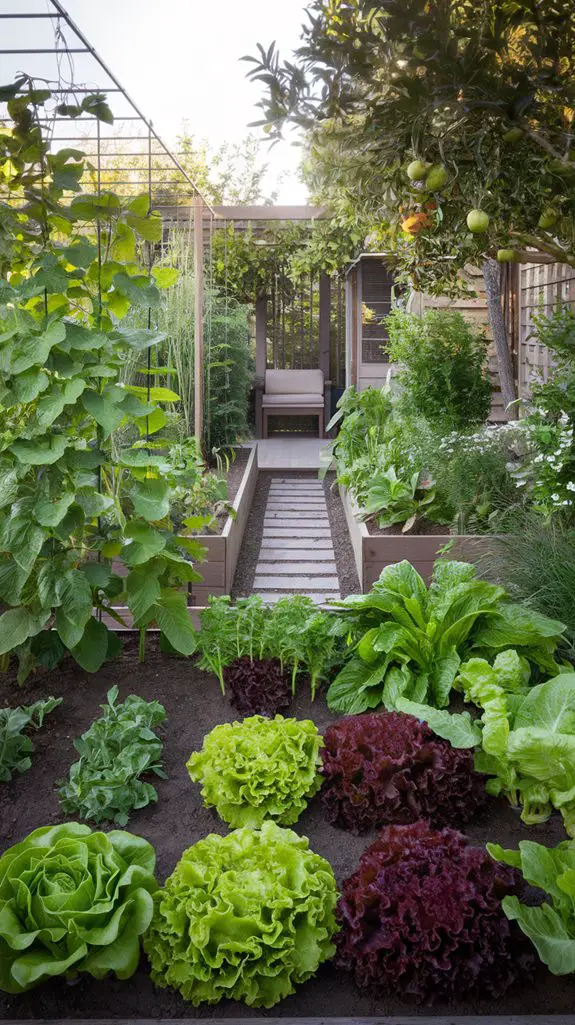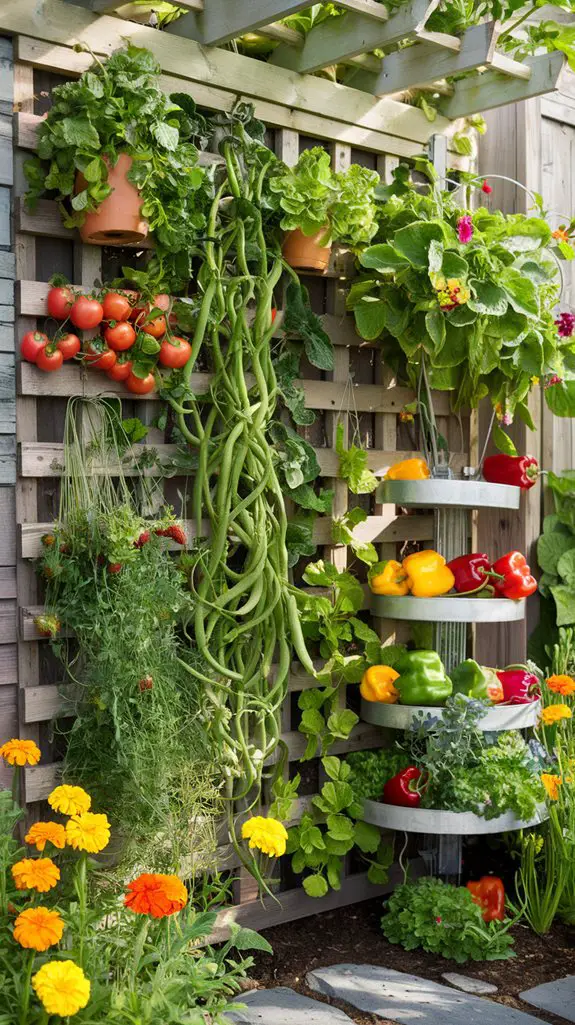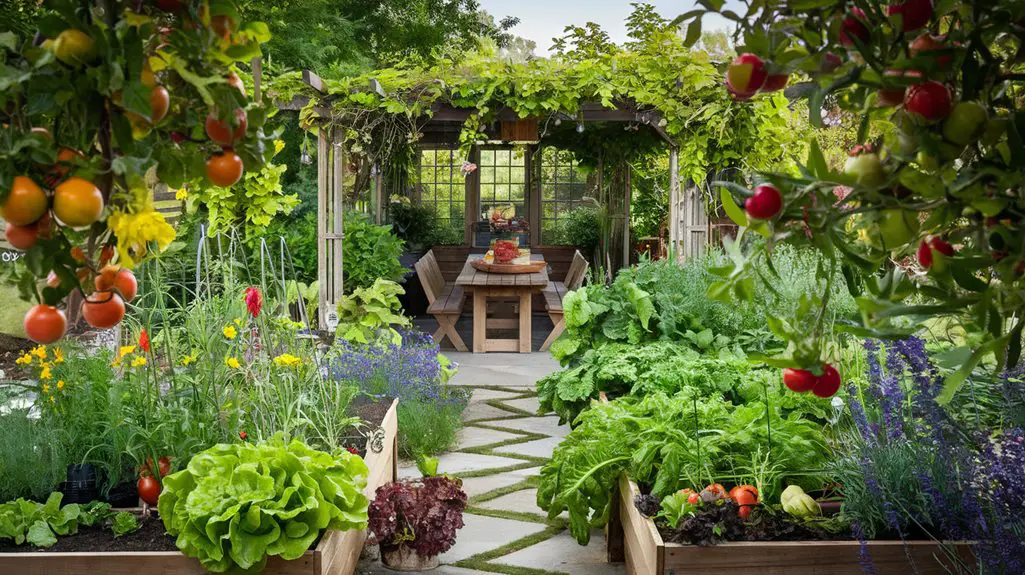Designing an edible backyard landscape is about utilizing space, enhancing soil, and embracing nature. You want to assess your area, evaluate your soil, and select plants that thrive in your climate. By understanding these elements, you can create a productive garden that's both functional and beautiful. But how do you organize all these factors to achieve a harmonious balance? Let's explore the steps to transform your outdoor space into a thriving edible paradise.
Assessing Your Space and Soil Conditions
Before you immerse yourself in designing your edible backyard landscape, it's essential to assess your space and soil conditions.
Start by measuring your area—how much sunlight does it receive? Observe the shade patterns throughout the day and note any obstructions like trees or buildings.
Next, dig a small hole to test your soil. Is it sandy, clayey, or loamy? This will affect drainage and nutrient content.
Don't forget to check the pH level; most edible plants thrive in slightly acidic to neutral soil. If your soil's lacking, consider amending it with compost or organic matter.
Choosing the Right Edible Plants for Your Climate
With a solid understanding of your space and soil, it's time to turn your attention to selecting the right edible plants for your climate.
Choosing plants that thrive in your specific conditions will lead to a more fruitful garden. Here are some tips to guide your selection:
- Research your climate zone – Know if you're in a warm, temperate, or cool region.
- Choose native plants – They adapt easily and provide food for local wildlife.
- Consider seasonal growth – Select a mix of cool-season and warm-season crops for year-round harvests.
- Look for disease resistance – Opt for varieties known to resist local pests and diseases.
Designing Functional Garden Beds and Layouts

Creating functional garden beds and layouts is essential for maximizing your edible landscape's productivity and accessibility.
Start by considering raised beds; they improve drainage and soil warmth while reducing weed issues. Arrange your beds in a layout that allows easy access from all sides—think pathways that are at least 2 feet wide.
Group plants with similar watering and sunlight needs together to simplify care. Don't forget to maximize vertical space; trellises or wall planters can add extra growing area. Incorporate wide, easily navigable aisles to guarantee you can reach every plant without stepping onto the soil. Additionally, consider using budget-friendly ideas to construct your raised beds, which can help keep costs low while enhancing your garden's functionality.
Incorporating Companion Planting for Healthier Growth
When you strategically pair plants in your edible landscape, you not only boost their growth but also enhance the overall health of your garden.
Companion planting creates a symbiotic relationship among plants, helping them thrive together. Here's how you can implement it:
- Tomatoes and Basil: Basil repels pests that typically target tomatoes, enhancing flavor and yield.
- Carrots and Onions: Onions deter carrot flies, while carrots can help aerate the soil.
- Beans and Corn: Beans fix nitrogen in the soil, benefiting corn, which needs it to grow tall.
- Cucumbers and Nasturtiums: Nasturtiums attract beneficial insects while deterring cucumber beetles.
Maximizing Vertical Space With Edible Options

Imagine transforming your backyard into a lush, productive haven by utilizing every inch of vertical space available. Vertical gardening not only saves ground space but also adds beauty and diversity. You can use trellises, hanging pots, or wall planters to grow a variety of edible plants. This method promotes sustainable living by encouraging eco-friendly practices that enhance both your garden and the environment.
Here's a quick reference for your vertical options:
| Edible Plant | Best Vertical Method |
|---|---|
| Tomatoes | Trellis |
| Cucumbers | Vertical Garden Frame |
| Strawberries | Hanging Baskets |
| Herbs (e.g., basil, mint) | Wall Planters |
Maintaining Your Edible Landscape Throughout the Seasons
As your edible landscape flourishes, you'll find that maintaining it throughout the seasons is essential for a bountiful harvest.
Each season brings unique challenges and opportunities, and staying proactive will guarantee your garden thrives.
Here are four key maintenance tips:
- Spring: Clear debris and prepare your soil. Start planting cool-season crops like lettuce and peas.
- Summer: Water regularly and mulch to retain moisture. Keep an eye out for pests and diseases.
- Fall: Harvest your crops and plant cover crops to enrich the soil. Trim back perennials and remove weeds.
- Winter: Protect your plants with mulch or row covers. Plan your spring garden during the quiet months.
Conclusion
Designing your edible backyard landscape is like crafting a recipe; each ingredient plays a crucial role in creating a harmonious dish. By evaluating your space, choosing the right plants, and incorporating thoughtful layouts, you can cultivate a garden that thrives and delights. Remember, your garden will evolve with the seasons, just like you do. With care and creativity, you'll harvest not just food, but joy and beauty from your very own edible oasis.




